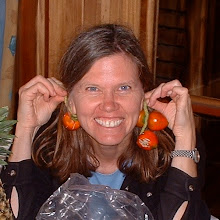Last year I wrote about working with two Guatemalan women, Berta Mendoza and her daughter Sofia in Panajachel, who I commissioned to embroider some temari for me. A year later, I was back. This time Berta embroidered two more balls for me. She felt—and I agreed—that her attempts this year were even more successful because she was more used to embroidering on a ball. If only I were such a quick learner, but the fact is that Berta has a lot more experience embroidering. Her balls this year featured birds like last year but she also used flowers.
Berta liked that I had put a simple four division on the ball with gold thread. It helped her visualize where on the ball to put her designs.
A second ball was on a lovely maroon background. I removed some of my marking thread when Berta was done because I preferred it when a line didn't go through a bird. (This ball had a simple four with equator and I removed some of the equator.) Look as this wonderful hummingbird. Usually Berta invents her own species of birds.
Again this year I spent a lot of time in Berta's store watching her stitch and sharing lots of laughs. It was very interesting to watch her select colors. It's a lot like my own technique: just holding up new colors next to the ball to choose the next color to use. I usually enjoy not having all my colors chosen before I do a project.
Here's another side of the same ball. with a very lively bird. I want to go to the universe where I can see Berta's birds.
I was so grateful to be able to spend time with my Guatemalan friends and cherish the balls they embroidered for me.
Berta liked that I had put a simple four division on the ball with gold thread. It helped her visualize where on the ball to put her designs.
A second ball was on a lovely maroon background. I removed some of my marking thread when Berta was done because I preferred it when a line didn't go through a bird. (This ball had a simple four with equator and I removed some of the equator.) Look as this wonderful hummingbird. Usually Berta invents her own species of birds.
Again this year I spent a lot of time in Berta's store watching her stitch and sharing lots of laughs. It was very interesting to watch her select colors. It's a lot like my own technique: just holding up new colors next to the ball to choose the next color to use. I usually enjoy not having all my colors chosen before I do a project.
I was so grateful to be able to spend time with my Guatemalan friends and cherish the balls they embroidered for me.



































